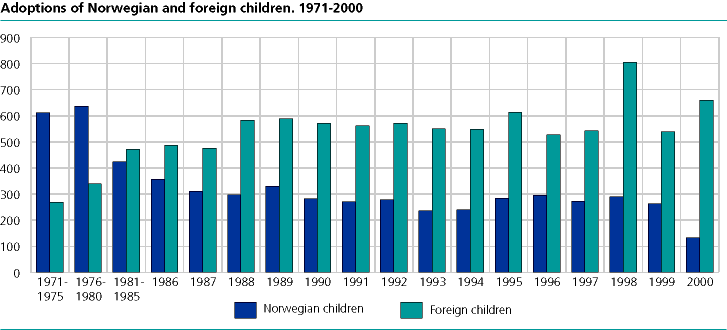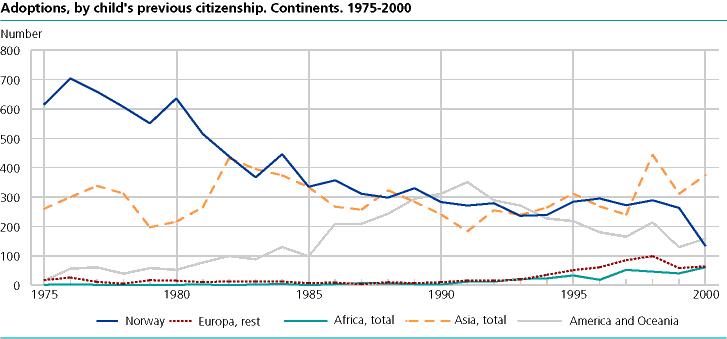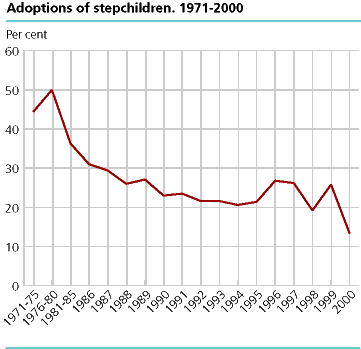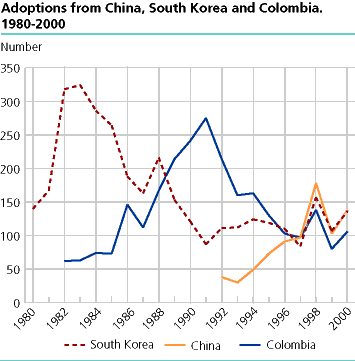Content
Published:
This is an archived release.
Foreign adoptions increasing
Almost 800 children were adopted in Norway last year. Out of which 660 were from abroad. The total number has been stable since the 1960s and is between 800 - 900 yearly. The distribution of Norwegian and foreign adopted children have however changed significantly.
Steady increase in number of foreign children...
Adopted children with foreign citizenship accounted for 83 per cent of all adoptions in 2000 compared with 67 per cent the previous year. The yearly average was about 52 per cent between 1980 and 1985 and 31 per cent between 1971 and 1975. Of all the children adopted in 2000, 57 per cent had Asian background. The adoptions were mainly from China with a total of 138 children in 2000, 136 from South Korea, 106 from Columbia, 59 from Ethiopia and 49 from India. Only 30 Norwegian children were adopted through the stepchild adoptions and this accounted for only 4 per cent of the total. In the 1970s, 50 per cent of this group were Norwegians.
... and steady reduction of stepchild adoptions
The percentage of stepchild adoptions has declined since the 1980s and 1990s. Compared with the 1970s, the decline is significant. Nearly 50 per cent (400 children) of all adoptions were stepchildren, compared with 13 per cent (105 children) in 2000. These were mostly Norwegian children; 103 out of a total of 105 stepchildren adoptions in 2000 were Norwegians.
Changes in the distribution of adoption countries
China, which tops the list, first became an adoption country in the last half of the 1990s. South Korea dominated in the early 1980s but there was a decline in adoptions after 1984. At the same time Columbia became a major country.
Adoptions from Brazil, Chile and The Philippines have declined during the 1990s, and those from India have risen. New countries have joined the existing number of adoption countries, and these are Ethiopia, Romania, Russia and Hungary.
Most adoptions in Western Norway
In relation to the population within the age group 25 44 years, the national average was 0.60 per
1 000 inhabitants. Counties with most adoptions in 2000 were Rogaland (0.87), Hordaland (0.79) and Møre and Romsdal (0.75) fewest in Hedmark (0.36), Sør-Trøndelag (0.46) and Nord-Trøndelag (0.47).
Gender and age distribution
The gender breakdown shows 370 boys and 420 girls. Boys were in the majority in the adoptions from Africa, South America, South Korea and European countries except for Norway. The girl majority in total is due to the fact that as previously most all of the adoptees from China were girls. Most adoptions from India were also girls. Most of the adoptees were under 3 years old (530 children), mainly within the age group 1-2 years (390 children).
Who can adopt?
See law on adoption of 28.02.1986 nr.8 at:
http://www.lovdata.no/all/nl-19860228-008.html
The Adoption Statistics are published yearly.
Tables:
- Table 1 Adoptions, by the relationship of the adoptive parents to the child before adoption, and by the child's previous citizenship. 1966-2000
- Table 2 Adoptions, by the relationship of the adoptive parents to the child before adoption, and by the child's previous citizenship, sex and age. 2000
- Table 3 Adoptions, by the child's sex, age and previous citizenship. 2000
Contact
-
Statistics Norway's Information Centre
E-mail: informasjon@ssb.no
tel.: (+47) 21 09 46 42
-
Oppdrag innvandring
E-mail: oppdraginnvandring@ssb.no
-
Alice Steinkellner
E-mail: alice.steinkellner@ssb.no
tel.: (+47) 90 72 90 51




